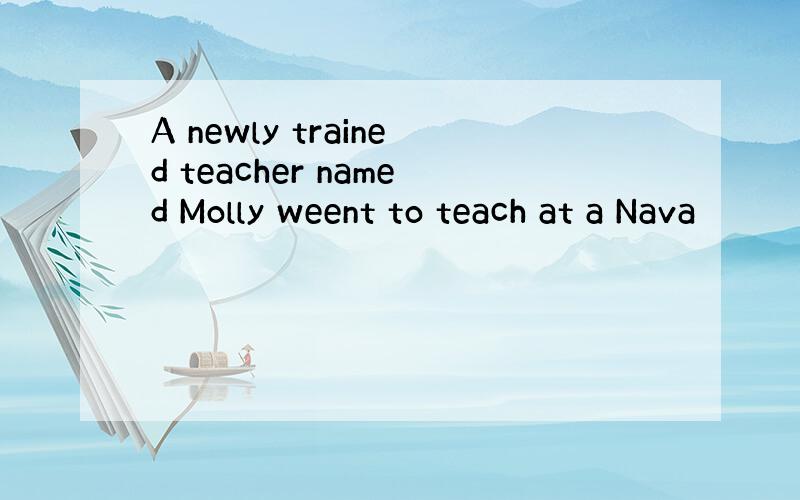A newly trained teacher named Molly weent to teach at a Nava
来源:学生作业帮 编辑:神马作文网作业帮 分类:英语作业 时间:2024/11/16 16:12:46
A newly trained teacher named Molly weent to teach at a Navajo Indian reservation
这是一篇完形填空希望能给各位大神帮我解难,有重赏
这是一篇完形填空希望能给各位大神帮我解难,有重赏

A newly trained teacher named Mary went to teach at a Navajo Indian reservation. Every day, she would ask five of the young Navajo students to __1__ the chalkboard and complete a simple math problem from 2 homework.
They would stand there, silently, 3 to complete the task. Mary couldn’t figure it out. 4 she had studied in her educational curriculum helped, and she 5 hadn’t seen anything like it in her student-teaching days back in Phoenix.
What am I doing wrong? Could I have chosen five students who can’t do the 6 ? Mary would wonder. No, 7 couldn’t be that. Finally she 8 the students what was wrong. And in their answers, she learned a 9 lesson from her young 10 pupils about self-image and a(n) 11 of self-worth.
It seemed that the students 12 each other’s individuality and knew that 13 of them were capable of doing the problems. 14 at their early age, they understood the senselessness of the win-lose approach in the classroom. They believed no one would 15 if any students were shown up or embarrassed at the 16 . So they 17 to compete with each other in public.
Once she understood, Mary changed the system 18 she could check each child’s math problem individually, but not at any child’s expense 19 his classmates. They all wanted to learn, 20 not at someone else’s expense.
1. A.go to B.come to C.get close to D.bring
2. A.his B.their C.his own D.her
3. A.happy B.willingly C.readily D.unwilling
4. A.Anything B.Nothing C.Everything D.Neither
5. A.almost B.certainly C.hardly D.never
6. A.question B.chalkboard C.problem D.homework
7. A.they B.it C.everything D.each
8. A.asked B.questioned C.told D.understood
9. A.outstanding B.surprising C.annoying D.frightening
10.A.sunburned B.tender C.Indian D.naughty
11.A.sense B.image C.way D.aspect
12.A.had B.ignored C.respected D.cared
13.A.none B.no one C.each D.not all
14.A.Especially B.Even though C.Even so D.Even
15.A.lose B.win C.achieve D.answer
16.A.time B.situation C.chalkboard D.condition
17.A.refused B.rejected C.tried D.promised
18.A.if B.so that C.unless D.in case
19.A.in favour of B.of C.by means of D.in front of
20.A.and B.but C.so D.or
1.A 每天让五个Navajo Indian(纳瓦霍印第安)学生上黑板做简单的数学题
2.B 根据上文中的five of the young Navajo students,这里用their.
3.D 学生不愿意在黑板上做.
4.B;
5.B 为什么学生不愿在黑板上做?Mary弄不明白了.她在教育课程中学到的东西也不能帮助她弄清这个问题,且她在Phoenix教学生的那些日子当然不会遇到这样的事情.
6.C Mary开始反思:是不是我选了五个不会做这道题的学生?
7.B 情况不是那样.这里用it,代指上文提到的事情.
8.A 根据下文的“answers”,这里应该用asked.
9.B;
10.C;
11.A Mary从纳瓦霍印第安小学生了解到他们的自我形象意识和自尊感,这令她感到惊讶.
12.他们尊重彼此的个性.表示“尊重”用“respected”.
13.他们知道并不是所有的学生都能做出那些数学题.“并不是所有的”表示部分否定,用“not all”.
14.D even 在这里表示强调.
15.B; 16.A 他们认为如果任何人在黑板前被揭露出不会做或者感到尴尬,他们都会成为失败者.
17.他们拒绝在公共场所彼此竞争.这里要用“refuse”,reject 含有“拒绝接受”之意.
18.so that “以便”.
19.in front of his classmates 在同学面前.
20.but 表示转折
They would stand there, silently, 3 to complete the task. Mary couldn’t figure it out. 4 she had studied in her educational curriculum helped, and she 5 hadn’t seen anything like it in her student-teaching days back in Phoenix.
What am I doing wrong? Could I have chosen five students who can’t do the 6 ? Mary would wonder. No, 7 couldn’t be that. Finally she 8 the students what was wrong. And in their answers, she learned a 9 lesson from her young 10 pupils about self-image and a(n) 11 of self-worth.
It seemed that the students 12 each other’s individuality and knew that 13 of them were capable of doing the problems. 14 at their early age, they understood the senselessness of the win-lose approach in the classroom. They believed no one would 15 if any students were shown up or embarrassed at the 16 . So they 17 to compete with each other in public.
Once she understood, Mary changed the system 18 she could check each child’s math problem individually, but not at any child’s expense 19 his classmates. They all wanted to learn, 20 not at someone else’s expense.
1. A.go to B.come to C.get close to D.bring
2. A.his B.their C.his own D.her
3. A.happy B.willingly C.readily D.unwilling
4. A.Anything B.Nothing C.Everything D.Neither
5. A.almost B.certainly C.hardly D.never
6. A.question B.chalkboard C.problem D.homework
7. A.they B.it C.everything D.each
8. A.asked B.questioned C.told D.understood
9. A.outstanding B.surprising C.annoying D.frightening
10.A.sunburned B.tender C.Indian D.naughty
11.A.sense B.image C.way D.aspect
12.A.had B.ignored C.respected D.cared
13.A.none B.no one C.each D.not all
14.A.Especially B.Even though C.Even so D.Even
15.A.lose B.win C.achieve D.answer
16.A.time B.situation C.chalkboard D.condition
17.A.refused B.rejected C.tried D.promised
18.A.if B.so that C.unless D.in case
19.A.in favour of B.of C.by means of D.in front of
20.A.and B.but C.so D.or
1.A 每天让五个Navajo Indian(纳瓦霍印第安)学生上黑板做简单的数学题
2.B 根据上文中的five of the young Navajo students,这里用their.
3.D 学生不愿意在黑板上做.
4.B;
5.B 为什么学生不愿在黑板上做?Mary弄不明白了.她在教育课程中学到的东西也不能帮助她弄清这个问题,且她在Phoenix教学生的那些日子当然不会遇到这样的事情.
6.C Mary开始反思:是不是我选了五个不会做这道题的学生?
7.B 情况不是那样.这里用it,代指上文提到的事情.
8.A 根据下文的“answers”,这里应该用asked.
9.B;
10.C;
11.A Mary从纳瓦霍印第安小学生了解到他们的自我形象意识和自尊感,这令她感到惊讶.
12.他们尊重彼此的个性.表示“尊重”用“respected”.
13.他们知道并不是所有的学生都能做出那些数学题.“并不是所有的”表示部分否定,用“not all”.
14.D even 在这里表示强调.
15.B; 16.A 他们认为如果任何人在黑板前被揭露出不会做或者感到尴尬,他们都会成为失败者.
17.他们拒绝在公共场所彼此竞争.这里要用“refuse”,reject 含有“拒绝接受”之意.
18.so that “以便”.
19.in front of his classmates 在同学面前.
20.but 表示转折
一道SAT语法IS题(a squadron of newly trained,enthusiastic firefigh
I want to fand a teacher to teach me english
we need a math teacher( )math A.to teach B.teach C.teaching
we need a teacher to teach可以这么说吗
You can get a teacher to teach you English,为什么用to teach
请翻译I am a trained Waldorf teacher
It is very important for a teacher t teach things to teach t
I 'd like to be a teacher.(一般疑问句)____ you ____ to be a teach
———a teacher , I" try to teach my students well. A:TO B:For
Molly,let your sister_____you,OK?A.help B.to he
A,training B,trained C,being trained ,D,to be t
he began to teach in that school( )a math teacher in 2000 A